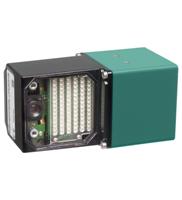Vision Sensors Detect Incorrect Sheets in Print Finishing
Task
An unprinted page in a novel is annoying, and if the reader therefore misses required information, he will put away the book. Such incidents are inconvenient but they are by far not as potentially perilous as a mixup of package inserts of drugs. In each case the bookbindery folded, collated or bound the wrong sheet. To avoid this, the incorrect sheets should be reliably identified and separated in time to ensure the finishing from exclusively correct sheets.
Previously the sheets were labeled with a barcode or a Data Matrix code. In addition to the added cost of applying these codes, there is also the disadvantage that the barcode is often cut off early in the process for many printed products, and thus is no longer available when needed for inspection. Furthermore, pure barcode readers with their typical line scan design have the disadvantage that codes can only be detected in lateral direction to sheet movement. As an alternative to code readers, there are the first discrete solutions for print image comparison, which, however, results in additional investment for the additional device and in not inconsiderable expenditure for installing both systems.
Implementation

Fig. 1: The sheet identification sensor VOS410-BIS compares both, print images and Data Matrix codes
Vision sensors detect incorrect sheets based on the actual printed image. For this task the different image types (text, photographs and graphics) have to be detected fast. The German company Pepperl+Fuchs has developed the sheet identification sensor VOS410-BIS to comply with these requirements. It monitors the correct sheet fold in collating and folding machines and proofs the conformity of the actual camera image with a previously taughtin reference image or reference code. The vision sensor, which has been developed especially for the graphics industry, detects the significant differences.
Put into Practice
The German company Wohlenberg Buchbindesysteme (Wohlenberg Bookbinding Systems) is using vision sensors from Pepperl+Fuchs in collating machines and adhesive binders for the detection of incorrect sheets. Camera, lighting and processing unit is integrated into a complete compact system, which does not need any external processing unit. With two evaluation methods in one device, barcode and image comparison, integration effort is significantly reduced. With a maximum sheet speed of 6 m/s and a cycle time below 80 ms, the vision sensor is suitable for high processing speeds and still has free resources for faster processes in the future. Further degrees of freedom are achieved by the integrated rotary encoder interface for simultaneous offset of the trigger point. An error image memory stores the results of the evaluating unit and allows the simulation of false detections. This memory supports the user also in the setup process and in problem analysis. Also in normal operation mode, the fast image transfer enables a visual check-up and plausibility check. Crucial for Wohlenberg’s purchase decision was the fact that this vision sensor is produced entirely by Pepperl+Fuchs. Therefore, long-term availability has been ensured.

Fig. 2: VOS410-BIS-60-WH successful in practice





 +46 303 246070
+46 303 246070